Intel PPSTCK1A32WFC Bay Trail-T Compute Stick Review
by Ganesh T S on April 22, 2015 11:00 AM EST- Posted in
- Systems
- Intel
- Bay Trail
- HDMI Stick
Performance Metrics
The Intel PPSTCK1A32WFC ships with Windows 8.1 x86 because the driver support for the Atom SKUs belonging to Bay Trail-T is restricted to Windows 8.1 x 32 bit, and Android x 64 bit. This meant that many of the benchmarks in our standard test suite for low power desktops / industrial PCs could not be processed on the Compute Stick.
Futuremark PCMark 8
PCMark 8 provides various usage scenarios (home, creative and work) and offers ways to benchmark both baseline (CPU-only) as well as OpenCL accelerated (CPU + GPU) performance. We benchmarked select PCs for the OpenCL accelerated performance in all three usage scenarios. Larger-sized systems that beat the Compute Stick in the benchmarks below usually have desktop or notebook-class Bay Trail SoCs. They are clocked higher and also have better thermal solutions.
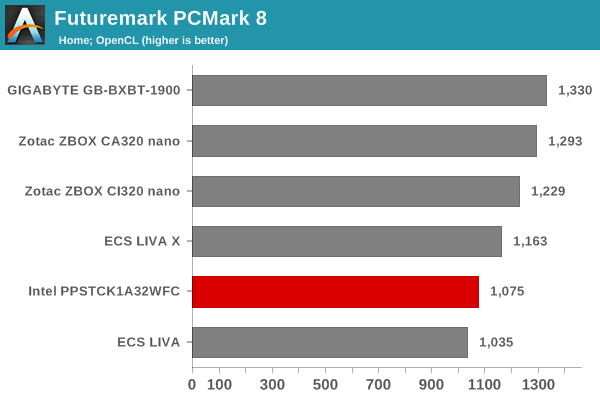

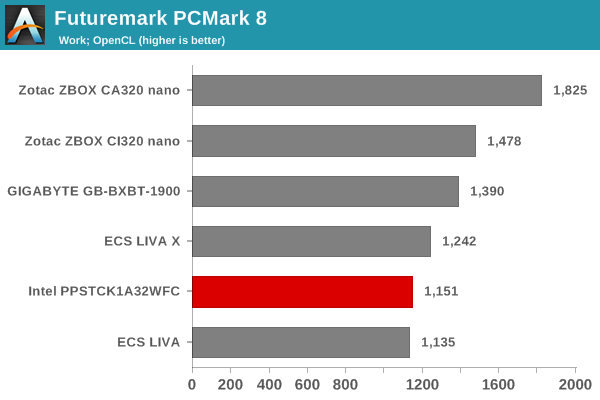
Miscellaneous Futuremark Benchmarks
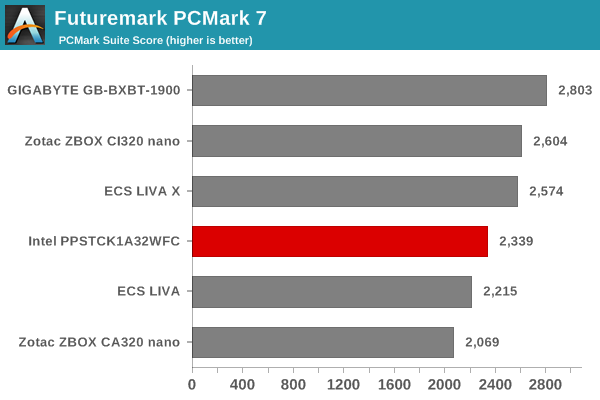
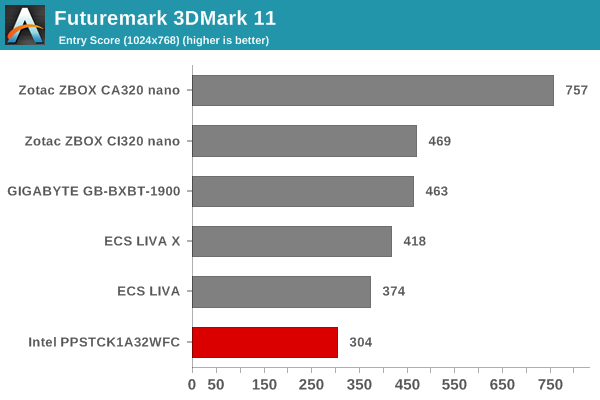
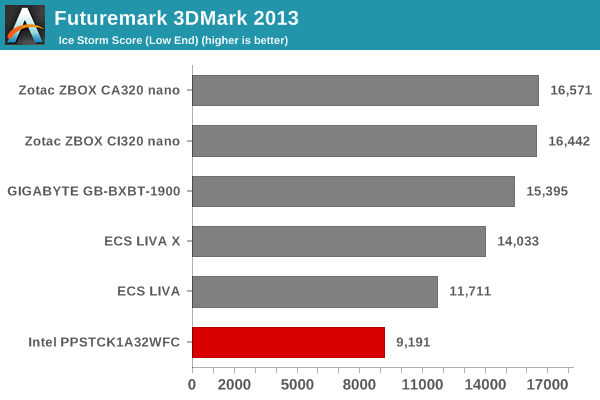
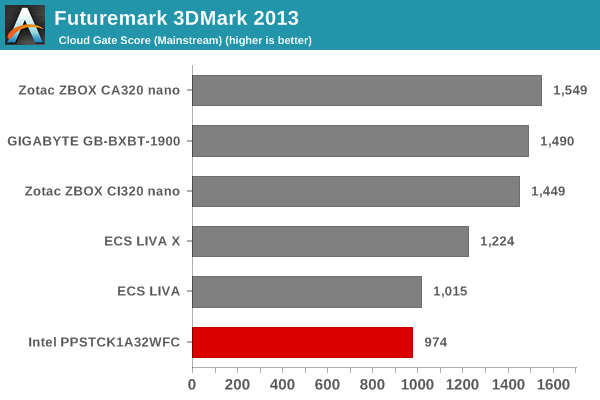
In the other Futuremark benchmarks evaluating 3D performance, we find the Compute Stick coming in last - this was to be expected, given that the GPU is clocked low at 311 MHz and also happens to operate mostly in the thermal limits put in place for a tablet platform.
We now move on to look at the benchmark modes in programs used on a day-to-day basis, i.e, application performance and not synthetic workloads.
x264 Benchmark
First off, we have some video encoding benchmarks courtesy of x264 HD Benchmark v5.0. This is simply a test of CPU performance. The Compute Stick manages to score better than the ECS LIVA in most of these tests thanks to the four cores (compared to the two in the latter).
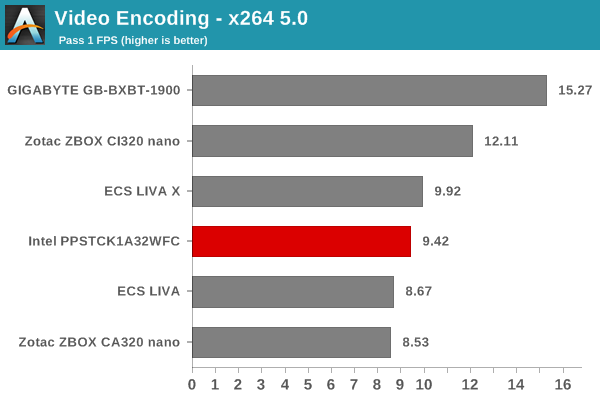
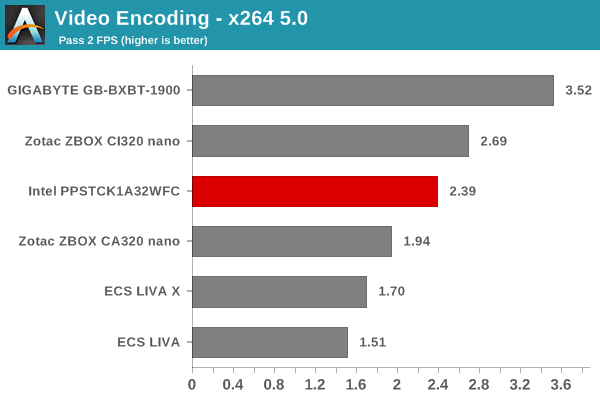
7-Zip
7-Zip is a very effective and efficient compression program, often beating out OpenCL accelerated commercial programs in benchmarks even while using just the CPU power. 7-Zip has a benchmarking program that provides tons of details regarding the underlying CPU's efficiency. In this subsection, we are interested in the compression and decompression MIPS ratings when utilizing all the available threads. Again, the advantages of a quad-core SoC come through.
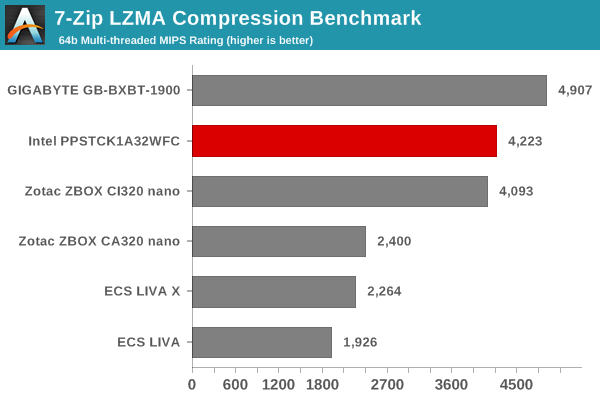
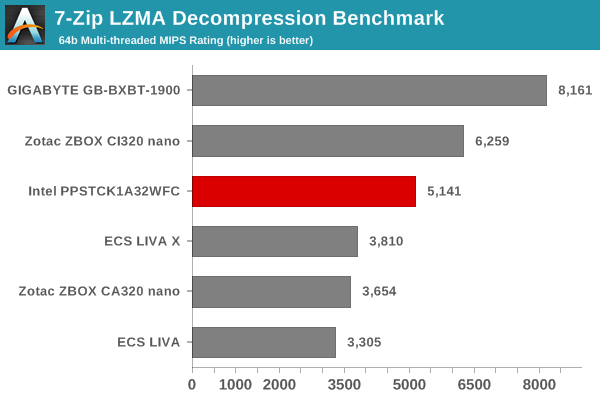
TrueCrypt
As businesses (and even home consumers) become more security conscious, the importance of encryption can't be overstated. CPUs supporting the AES-NI instruction for accelerating the encryption and decryption processes have, till now, been the higher end SKUs. However, with Bay Trail, even the lowly Atom series has gained support for AES-NI. It is quite unlikely that any usage scenario for the Compute Stick is going to involve extensive encryption capabilities. However, the presence of AES-NI support in the Compute Stick's SoC piqued our interest.
TrueCrypt, a popular open-source disk encryption program can take advantage of AES-NI. Its internal benchmark provides some interesting cryptography-related numbers to ponder. In the graph below, we can get an idea of how fast a TrueCrypt volume would behave in the Intel PPSTCK1A32WFC and how it would compare with other select PCs. This is a purely CPU feature / clock speed based test. Interestingly, the Atom Z3735F is the only Bay Trail SoC in the graph below to have AES-NI capabilities.
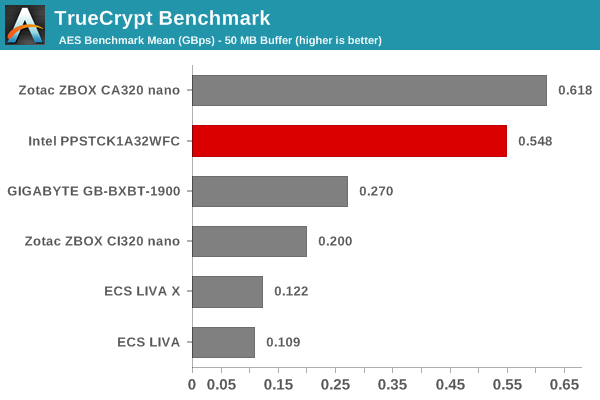










103 Comments
View All Comments
Arnulf - Wednesday, April 22, 2015 - link
Looks like a massive fail, but then again what else to expect from such a small form factor ...kyuu - Wednesday, April 22, 2015 - link
If you think this is a "massive fail", the problem is probably more your expectations than the product.jospoortvliet - Wednesday, April 22, 2015 - link
Or he's comparing it to the competition... Chromecast for one. It might not be as powerful but what it does it does well - without an annoying fan or bad/unreliable wifi. And at a very low price.Yeah, this doesn't impress me either, mostly due to the failure to make this fanless. The drive size is fine (put Linux with Kodi on it) but the bad wlan - that is a fail, too.
Still, yeah, first gen, Intel is good at incremental improvement so I bet gen 2 will be much much better.
JeffFlanagan - Wednesday, April 22, 2015 - link
This isn't something comparable to a Chromecast. Chromecast is an extremely limited device. I've already replaced one with a much more capable Fire stick, and may replace the other with one of these or another low power PC.usernametaken76 - Wednesday, April 22, 2015 - link
I'm going to have to agree with you on that, Jeff. This does what they say it does, and it runs Windows. So you can build and compile your own local applications and there's no need for a "network" operating system like ChromeOS. For some users, that's what they want and/or need. You could easily build a Plex server and run the Plex app on this device and be quite happy, I'll assume. It would be nice to have more of a "user experience" review. Performance metrics are interesting, but if I spend $150 on an HDMI stick, I don't care how fast it can encode video, decrypt files, etc. I care how it will perform as a media streamer, can it run any games (highly limited here), can it be a remote streamer for Steam (unlikely for this first gen device), etc. That's what matters to me for something like this.Deelron - Wednesday, April 22, 2015 - link
The first thing I thought when I saw it was Plex server, but the networking solution isn't sufficient enough in my book. While I guess you could add a USB to Ethernet dongle (or thumb wireless solution), that seems kludgey at best. It's an interesting step towards something more usable in the future.usernametaken76 - Wednesday, April 22, 2015 - link
If you mean "Plex client" with the server running elsewhere, then I think its existing wireless is already sufficient. Plex "tops out" at 20 Mbps for streaming, and that's adjustable in the client all the way down to sub HD speeds < ~3 Mbps. You have the option to transcode everything on the Plex server when doing this, and Intel's stick here would be more than capable of handling that situation, provided there's not a lot of WiFi interference on the 2.4 GHz band. If it's 5 Ghz (admit I didn't read the full specs) then less so, but distance is the issue.bigkev1978 - Wednesday, April 22, 2015 - link
Massive fail seems like a bit harsh... I will admit that I haven't used the Compute Stick but I have had a Hannspree Micro PC (www.stickpcstore.com/stick-pcs/hannspree-windows-8-stick-pc-quad-core-1-83-ghz-2gb-ram-32gb-windows-8-1-micro-pc-snnpdi1b.html) for a couple of months and it is very similar spec to the Compute Stick... and it is great... yes it is not an i5 or i7 PC... but it does "light productivity" really well... Word, Excel, Outlook... browsing the web. I've got in plugged into my front room TV (42") and use it occasionally all the time. I agree the WiFI could be better but hopefully this will be a second gen update.Refuge - Wednesday, April 22, 2015 - link
I was reading MAXPC's review, its up on their site. They don't obviously offer the kind of solid quantifiable metrics that I get here, but they are usually good for a user experience overview.They said that it streamed everything from YouTube, Netflix, Hulu to steam in home perfectly. Playing games with no noticeable input lag, and that it streamed 1080p videos without a problem.
The way they described the fan, is that it was just a high pitched hum that you wouldn't hear unless you were in a dead silent room, which is something that I would never deal with if this were on my living Room TV.
They said they got something like 20 FPS on Portal 1 playing it from the stick itself.
azazel1024 - Wednesday, April 22, 2015 - link
I am a little dissapointed (especially the neutered GPU chops, even compared to other Baytrail SoCs), but at the same time, it seems like it would make a perfectly good LIGHT HTPC. I am not super interested this time around, but if the price stays the same, I might be very interested with Cherry Trail if the drop in process size helps out with maintaining higher frequencies under load, better GPU, etc.